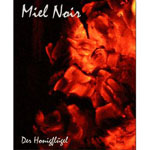
CD, The Eastern Front, 2009
www.myspace.com/mielnoirscapes
Miel Noir is yet another face of the prolific Bulgarian artist Dimo Dimov who has played various roles in Allerseelen, Sturmpercht and Sagittarius and his other solo project Svarrogh. This release, however, is neither martial nor neo-folk. It is inspired by the works of Russian authors Dostoevsky and Goncharov and uses classical piano samples and Russian film dialogue to conjure an appropriately sombre atmosphere. The significance of the honey (honig) theme is seems to be for the listener to decipher.
The opening title track defines the sonic formula that the album will follow from there on in – lightly processed and occasionally atonal classical piano offset by various effects. The piano sometimes proceeds slightly haltingly, and at other times more mournfully, with occasional brighter notes. This is the “backbone” of the album around which other elements circle – in this case ominous rumbling and searing tinnitus-like frequencies.
With “Honigglut” voices enter the mix – initially near whispered vocals and then the agitated voice of a woman in distress, meanwhile the piano continues its meandering progress. They way in which the piano unfolds throughout the album is disappointing in that it never truly descends or breaks down, which would probably have been more interesting, both sonically and dramatically. As it is, the album is perhaps too respectful of its sources and seems to lack the will or the aesthetic courage to subject them to more radical transformation. It does work together as a single flowing suite, but this depends on how much of the often unvarying piano sound the listener can take.
“Honigäther” eventually introduces increasingly sombre reverberations and with them a more active sense of tension. This is the track where the album’s formula works most effectively. “Honignebel” continues a gradual but cautious journey into slightly darker territory, marked by deep, gong-like sounds, dialogue and electronic effects. The closing “Honigmund” also opens in a sombre style but gradually brightens up as increasingly luxurious chords emerge. At some moments this brighter mode seems reminiscent of Dutch pianist Wim Mertens’ work, which is a surprising comparison in this context.
Understanding Russian or even recognised the sampled films would probably add much more to the Honigflügel experience. A dramatic, if not tragic, story is being told here – but you can always invent your own and the cinematic arrangement of the sound seems to invite this. Still, although this is a unique and intriguing work that’s perfect for atmospheric late night listening, there’s a sense that it could have gone further and transcended its sources more fully, rather than simply running through them.
[6/10]
— Alexei Monroe
